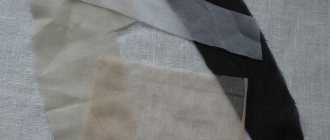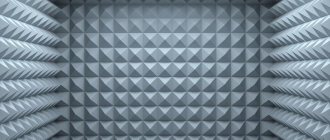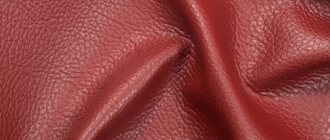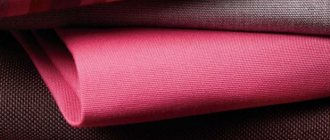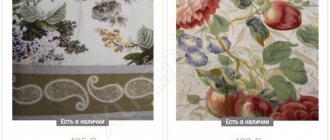Bast fibers
- Linen is one of the oldest textile fibers, but its use has declined since the invention of the cotton spinner.
- Ramie fibers are 10 to 15 cm long. The fibers are whiter and softer than flax. Ramie does not take dye well unless he is dry cleaned. Although natural ramie fiber is strong, it lacks durability, elasticity and elongation potential. Ramie fibers are resistant to mildew, insects and shrinkage. They are used for clothing, window treatments, rope, paper and table and bed linens.
- Hemp is similar to flax. The fibers range from 10 to 40 cm in length. Hemp has a low environmental impact: it does not require pesticides. It produces 250% more fiber than cotton and 600% more fiber than flax from the same amount of land. Hemp plants can be used to extract zinc and mercury contaminants from soil. Hemp is used for rope, clothing and paper. Addicts are willing to pay exorbitant prices for hemp clothing because it is associated with marijuana.
- Jute is one of the cheapest and one of the weakest cellulose fibers. Jute has low elasticity, elongation, sun resistance, mildew resistance and color fastness. It is used to make sugar and coffee bags, carpeting, ropes and wall coverings. Burlap is made from jute.
Leaf fibers
- Paina fiber is obtained from the leaves of the pineapple plant. They are used to make lightweight, clean, stiff fabrics for clothing, bags and table linens. Paina is also used to make mats.
- Abaca is a member of the banana tree family. The fibers are coarse and very long (up to half a meter). It is a strong, durable and flexible fiber used for ropes, floor mats, table linens, clothing and wicker furniture.
Natural fiber of mineral origin
Asbestos (Greek: indestructible) is the collective name for a group of fine-fiber minerals from the class of silicates. In nature, these are aggregates with a spatial structure in the form of the finest flexible fibers. It is used in a wide variety of fields, such as construction, the automotive industry and rocket science. In terms of its chemical composition, asbestos is aqueous silicates of magnesium, iron, and calcium and occurs in rocks in the form of veins and streaks. Asbestos does not burn.
Chemical fibers
Chemical fibers (artificial and synthetic) are obtained through complex chemical processing of natural and synthetic substances. The production of chemical fibers is growing rapidly. This is explained, first of all, by the high economic efficiency of production, huge resources of raw materials, high performance properties of these fibers, and the possibility of obtaining fibers with desired properties.
Man-made fiber is a chemical fiber made from natural
high molecular weight substances.
Synthetic fiber is a chemical fiber made from synthetic
high molecular weight substances.
Man-made fibers
Definition
Artificial fibers are obtained from natural substances of organic (cellulose, proteins) and inorganic (glass, metals) origin.
The idea of obtaining artificial fibers was first expressed in the 17th century, but their industrial production was carried out only at the end of the 19th century. The first type of artificial fiber of cellulose origin was nitrate silk, obtained in 1890. Somewhat later, a method for the industrial production of copper-ammonia fiber was found, and in 1898, the most common artificial fiber at present - viscose - was obtained. By the end of the First World War, a method for producing acetate fiber had been developed.
Viscose fiber
The chemical composition of viscose fibers is hydrated cellulose.
, which differs from natural cellulose in its shorter molecular chain length (n = 300 - 400) and lower degree of orientation of macromolecules in the fiber, which explains the difference in their properties.
The raw material for the production of viscose fiber is wood cellulose in the form of sheets, obtained by boiling spruce wood chips in a solution of calcium bisulfite. The viscose fiber production process consists of the following stages: pulp preparation, spinning solution, fiber spinning, viscose fiber finishing.
Viscose fibers are characterized by good hygroscopicity, light fastness, heat resistance, and breaking load. The disadvantages of viscose fiber are a small proportion of elastic elongation, which is why products made from this fiber have poor resistance to crushing; a large loss of strength when the fiber is moistened, which is explained by the penetration of water molecules into the intermolecular spaces of the fibers, which leads to a weakening of the cross-links of molecules, which largely determine the strength of the fibers; insufficient abrasion resistance. Viscose fibers burn like cotton.
Acetate fiber
According to the chemical composition, acetate fibers are cellulose acetate ester
. They differ from viscose in that they have lower hygroscopicity, heat resistance, breaking load and abrasion resistance, swell less in water and lose less strength when wet. Due to the greater elasticity of acetate fibers, products made from them retain their shape better and are more wear-resistant than those made from viscose fibers. The raw material for the production of acetate fiber is cotton or high-quality wood pulp.
Acetate fiber is dyed with special disperse dyes, which cannot dye viscose fibers. This makes it possible to obtain a variety of color effects on products made from a mixture of acetate and viscose fibers. Acetate fiber is dyed more deeply and evenly than viscose fiber, in addition, it can be given increased whiteness. Acetate fiber, unlike viscose fiber, is characterized by higher thermal insulation properties, light resistance and resistance to microorganisms, and transmits ultraviolet rays.
Acetate fiber burns with a yellow flame, spreading a specific sourish odor and forming an influx of dark color, which, after cooling, is easily crushed by fingers. If the flame is extinguished, the fiber slowly smolders, releasing a stream of smoke.
Coverage Requirements
1. COATING REQUIREMENTS
1.1. The coating should be used for fire protection of structures used indoors with a non-aggressive environment and a relative air humidity of no more than 75%.
1.2. The materials for preparing the coating composition, as well as the technology for applying it to structures, must meet the requirements given in the mandatory annex.
1.3. The fire resistance limits of steel structures depending on the thickness of the coating layer are given in Table 1.
Table 1
| Thickness of fire retardant coating, mm | Fire resistance limit of structures, h, not less |
| 10 | 0,75 |
| 20 | 1,5 |
| 30 | 2,0 |
| 40 | 2,5 |
| 50 | 3,0 |
1.4. The maximum deviation of the thickness of the applied coating layer from the design one in the direction of reduction should not exceed 5%.
1.5. The coating should not have cracks, peeling, or swelling.
1.6. The main physical and mechanical characteristics of the coating must correspond to those given in Table 2.
table 2
| Indicator name | Norm |
| Coating density, kg/m, no more | 250 |
| Ultimate compressive strength, MPa (kgf/cm), not less | 0,3 (3,0) |
1.7. The coating consists of the following components: granulated mineral fiber, liquid glass and nepheline fire retardant.
1.8. The consumption of components per 1 m of coating, taking into account production losses, is given in Table 3.
Table 3
| Component name | Consumption per 1 m of coating, kg |
| Granulated mineral fiber | 110 |
| Liquid glass with a density of 1.2 g/cm | 150 |
| Nepheline flame retardant | 30 |
1.9. The coating component is granulated mineral fiber, manufactured in accordance with clause 2.2 of the mandatory annex to this standard, with a moisture content of no more than 2%.
1.10. The coating component is potassium liquid glass with a module of 2.6-2.8 according to normative and technical documentation approved in the prescribed manner, or sodium liquid glass with a module of 2.6-2.8 in accordance with GOST 13078-81.
1.11. The coating component is nepheline flame retardant in the form of a fine powder according to regulatory and technical documentation approved in the prescribed manner.
1.12. The coating components must be supplied: liquid glass - in metal barrels, mineral fiber and fire retardant - in plastic or paper bags, and stored in accordance with the requirements of regulatory and technical documentation approved in the prescribed manner.
The art of sewing
Home » Selection of materials » Mineral chemical threads (fibers)
Mineral chemical threads include threads made from inorganic compounds - glass and metal.
Glass fiber (glass fiber)
Glass fibers are made from molten glass in the form of: • continuous fiber - elementary filaments of unlimited length with a diameter of 3-100 microns • staple fiber - segments 1-50 cm long and 0.1-20 microns in diameter.
Continuous glass fiber is formed by drawing from molten glass mass through dies (number of holes 200-2000) using mechanical devices, winding the fiber onto a reel. The fiber diameter depends on the drawing speed and the diameter of the spinneret. The technological process can be carried out in one or two stages. In the first case, glass fiber is pulled from molten glass mass (directly from glass melting furnaces), in the second, pre-obtained glass beads, rods or ercles (pieces of fused glass) are used, which are also melted in glass melting furnaces.
Staple glass fiber is formed in a one-step method by separating a stream of molten glass with steam, air or hot gases and other methods.
The properties of glass fibers are determined mainly by their chemical composition and are characterized by a rare combination of high heat resistance (for example, the heat resistance of quartz, silica, kaolin fibers is above 1000 ° C), high dielectric properties, low thermal conductivity, low coefficient of thermal expansion, high chemical resistance and mechanical strength.
Fiberglass in the form of bundles (rovings), twisted threads, tapes, fabrics of various weaves, non-woven materials is widely used in modern technology as a reinforcing (strengthening) material for fiberglass and other composite materials, as well as for the production of filter materials and electrical insulating products in electrical engineering. industry.
Combustion features: do not burn
Metal threads
Gold and silver threads were made from pure precious metal only in ancient times. Later they began to be made from alloys containing precious metals. Then they started producing gilded and silver-plated copper (tinsel) threads. Tinsel is a thin flattened silver-plated or gold-plated copper wire - flattened, twisted around a textile thread (cotton, silk or nylon). Tinsel was used in the production of brocade, braid and other bassonry products. Currently, metal threads are made of copper, brass, and nickel. Threads made of copper and brass are also produced with galvanic coating of gold or silver.
Metal threads are obtained by drawing (multiple sequential pulling of thick wire through gauge holes) or by cutting foil.
The threads obtained by drawing have a round cross-section. To obtain a flat thread, it is flattened. Currently, metal threads are produced in very limited quantities; they are used mainly for historical costumes, as finishing and decorative material, etc. For evening fabrics, alunit or plasticex is mainly used. Alunit (Lurex) - flat cut threads of aluminum foil in the form of ribbons 1-2 mm wide, coated with adhesives of various colors. Alunit is used in fabrics for a decorative effect. The disadvantages of alunit include its low strength. To increase strength, it can be twisted with a thin synthetic thread. Currently, alunit is being replaced with plasticex in a number of products.
Plastilex is a polyethylene film onto which sprayed metal is applied in a vacuum. This film is not only stronger than alunit, but also has some elasticity.
Metanite - metallized threads of rectangular cross-section. They are used to produce dress and decorative fabrics with a shimmering shine. Asbestos fiber is one of the mineral natural fibers; for detailed information about it, see the page “Asbestos fiber”
Information sources:
- Great Soviet Encyclopedia
- Kalmykova E.A. Materials science of clothing production: Textbook. Benefit, - Mn.: Higher. school, 2001- 412 p.
- Maltseva E.P., Materials science of clothing production, - 2nd ed., revised. and additional - M.: Light and food industry, 1983, - 232.
- Modestova T.A., Flerova L.N., Buzov B.A. Materials science of clothing production. Publishing house "Light Industry", 1969.
Tags: asbestos, asbestos fiber, fibers, fiber, materials science, mineral fibers, natural fibers, glass fiber
Published by Larisa Klepacheva on August 12, 2010. Posted in Selecting materials. Tags: asbestos, asbestos fiber, fibers, fiber, materials science, mineral fibers, natural fibers, glass fiber.
Previously in the same section:
- Characteristics of indicators and analysis of places of wear of products made from natural fur // April 22, 2012 //
- General scheme of weaving production // April 16, 2012 // 1
- Assortment of materials for dresses // April 10, 2012 //
- Sliding and fraying of edge threads in fabrics, impact on clothing production processes. Instruments and methods for their determination. Part 1 // April 2, 2012 // 2
- Ultrafine threads - microfibers and microthreads // August 8, 2010 //
Leave a comment or two
Click to cancel reply.
Fiber fillers
The base for this type of filler is long or short elementary fibers, both flexible and brittle. As a rule, fiber composites are obtained to impart special strength properties to a high-molecular compound. For this purpose, high-strength fibers made of glass, carbon (including carbon nanofibers or nanotubes), boron, polymer fibers, less often metal, carbides, nitrides, oxides and other inorganic compounds are used. Organic fibers of plant origin are also used, such as the previously mentioned cotton fiber.
Chopped short- and long-fiber and continuous fibers are used as fillers. In view of this, a fibrous composite may have properties similar to those of a dispersed material, or they may differ greatly from the latter and have distinctly reinforced or reinforced properties. When chopped fibers are used, the resulting materials can usually be easily processed using standard plastics processing methods such as extrusion and injection molding. When using long-fiber filler, such methods are not always available. The use of certain types of fibers can increase the mechanical properties of the finished composite by tens and hundreds compared to the original polymer.
Fig.1. Technical product made of glass fiber filled PA
The most popular fiber filler in the plastics processing industry is fiberglass. The industry produces many different brands of glass fibers, which differ in geometry, chemical composition and strength characteristics, but for the most part they are quite affordable. Fiberglass is used with almost all high-volume thermoplastic plastics, such as polyamide, polyethylene, polypropylene, polycarbonate, polyvinyl chloride, etc. At the same time, glass fiber is also actively used to reinforce thermosetting polymers, for example, materials based on epoxy and phenol-formaldehyde resins, unsaturated polyesters, etc.
Thermoplastics are usually filled with up to 40% glass fiber, less often up to 70%. Thermosets are filled with glass fiber in quantities up to 80%. Fiberglass also has its drawbacks: its high fragility and the sizing coatings used in fiber production that reduce adhesion to the polymer matrix.
Text
DESCRIPTION OF THE INVENTION FOR THE AUTHOR'S CERTIFICATE Union of Soviet and Socialist Republics 947112 (088.8) Date of publication of the description 30,07,82 FS, 10, Goberis, O, N. Nupman, B, V, Luzha; B,;B. Piktis, N. I, Pyatigorskaya, N, G. Samoilova, V, K, Yashni G. P. PROSKURinz All-Union Scientific Research Institute of Thermal Insulation 4 Yacin and Acoustic Building Materials and Products and Scientific Research Institute of Building Materials and Products (54) MINERLLS 1st FIBER GeOz Geo MO Sao MO KO Disadvantage 0.8 -120.1-4.00.5-1.08-204.5-210.1-55 of known compositions The invention relates to the production of thermal insulation materials, namely to compositions for the production of mineral fiber from silicate melt, The composition of glass for the production of mineral fiber is known.1, including, wt.%: 5 01 44.5-48.0 АСО3 7.0-10.0 Сао 17.0-32.0 М 00 2.0-4 .0Geo 0.3-1.1Ge aO 0.06-0.1 9Mt 0 6.0-1 9.0IO 0.5-1.5T 0 0.1-1.0Ga O 0.05-0.0 The closest to the proposed one is mineral fiber 21, including, wt.%: 50 27-61Ae 2 o, 8-23T 02 O; 30 there is a high melting point of the charge 1250-1400 C, as well as insufficiently high chemical resistance of the fiber obtained from it - acidity module (Mk) 1.6-2.38. In addition, mineral fiber is produced from the two most important components of the charge, which increases the cost of charge preparation departments , reduces the homogeneity of the melt and the quality of mineral wool products. The principle of the invention is to reduce the melting point, increase chemical resistance and reduce cost. The established chain of achievement is extinguished by the fact that the mineral fiber is 50, AE.O.G G, GL;m, 3 04711 CaO, MO, IO additionally contains PO with the following ratio of components, weight,% 2IOa 41.8 45.0AbkO 6.2-14.7T O 1.7-3.4RegOE 5.9-17.0GeO 13.2-14.4Mi O 0 .08-0.2CaO 4.3-7.8 OMR 8.5-13.11.1-2.8P O 0.3-2.1Specific mineral fiber compositions and their properties are given in the table. In order to obtain melts, they use sludge from bedrock ores, in particular the highly magnetic fraction of bedrock ore and the magnetic fraction of bedrock ore. The method of producing a melt for the production of silicate fibers is carried out as follows. They take one of the compositions, dry it in a drying drum to a moisture content of 3-5% and, using a piston or screw loader, feed it into the cooking zone of the Mchi bath. The use of waste from the enrichment of indigenous titanium ores will make it possible to obtain mineral fiber with increased chemical resistance. The reduced melting temperature of waste from the enrichment of indigenous titanium ores will ensure that technological melting processes are carried out at reduced temperatures in the working space of the furnace. This will reduce the specific heat consumption to produce 1 kg of melt, as well as increase the overhaul period of the melting units, since the corrosion of refractory materials decreases with a decrease in the temperature of the melt. The economic effect obtained when using the melt can be calculated by reducing fuel consumption by 15% and capital investments in the equipment of the charge preparation department. fermula Mineral fiber, including 10th, A 10 T 10, GeO, ReO, M&O, CaO, MO, IO, differing in that, with In order to reduce the melting point, increase chemical resistance and reduce cost, it additionally contains P 0 in the following ratio of components, wt.%: 1 O% 0 41.8-45.0 ABO 6.2-1 4.7 T, Oya
1.7-3.4 7 947112 8inventions EO 5.9 17.OPeO 1 3.2-14.4MiO ( ),08-0.2CaO 4.3-7.83 R 8.5-13.11, 1-2.80.3-2.1 Sources of information taken into account during the examination1. Copyright certificate USSRMo 581104, class, C 03 C 13/00, 1976.2
Author's certificate USSRMo 649670, class, C 03 C 13/00, 1977. Compiled by I, Ilyinykh Editor V, Petrash Techred T, fanta Proofreader E. Roshko Order 5515/35 Circulation 508 Subscribed VNIIPI of the USSR State Committee for Inventions and Discoveries 113035, Moscow, Zh, Raushskaya nab., 4/5 branch of PPP “Patent”, Uzhgorod, st., Proektnaya, 4
Look
Basalt superfine and thin staple fibers. Areas of use.
Due to the low cost of production, materials made from thin basalt staple fibers are widely used.
Industrial civil engineering - thermal insulation of enclosing structures, floors, roofs, facade insulation of buildings. Fire protection systems for buildings, metal structures. Thermal insulation of steam pipelines and heating mains. Thermal insulation in industry - furnaces and thermal equipment.
Due to the low cost of production, materials made from thin basalt staple fibers are widely used.
Application of basalt superfine fiber and BSTV materials
Energy – nuclear, thermal power plants, turbines, heating plants, steam boilers, heating mains; heat and sound insulation of thermal equipment.
Fireproof materials for fire protection systems: firewalls, protection of critical metal structures, fire doors, cable penetrations, etc.
Production of ceramics, porcelain, building materials - thermal insulation of furnaces and equipment for the production of ceramic and porcelain products (dishes, vases, sanitary ware, etc.), furnaces for the production of bricks, ceramic tiles.
Mechanical engineering – thermal insulation of thermal equipment, heating and hardening furnaces, heating mains.
Aviation industry - heat and sound insulating mats covered with waterproofing fabric for heat and sound insulation of engines and fuselage. The Soyuz spacecraft used BSTV. The materials have confirmed their high quality.
Shipbuilding – thermal insulation boards on an inorganic binder for heat and sound insulation of ship installations, equipment, ship hulls, bulkheads.
Cryogenic technology and equipment – insulation materials for the production of liquefied gases, liquid oxygen, etc.
Metallurgy – materials for thermal insulation of various types of technological furnaces and thermal equipment, regenerators, recuperators, pipelines, communications.
Chemical and petrochemical industry - thermal insulation of thermal equipment, heating furnaces, drying chambers, steam boilers, steam pipelines, heating mains; non-flammable, fire-resistant materials for fire protection of equipment and facilities.
Production of building materials and structures - insulated panels for prefabricated houses and structures, floors; suspended ceilings, fire bulkheads, firewalls, fire-resistant doors, building plastics.
Filters. BSTV is widely used for the production of filter materials and products, fine filters for air and liquid media, and high-temperature filters. BSTV produced at temperatures of 1400 – 1500°C is an ideal material for hydroponics when growing bacterial cultures, plant seedlings, etc.
Household appliances – thermal insulation of gas and electric stoves, ovens, electric ovens.
See also: Technologies and equipment for the production of super-thin basalt fiberTechnological equipment for the production of thermal insulation boards
Previous – Next >>
Additional information on pages “Glass threads”, “Gold and silver threads”Mineral chemical threads include threads made from inorganic compounds - glass and metal.
Glass fiber (glass fiber)
Glass fibers are made from molten glass in the form of:
- continuous fiber - elementary filaments of unlimited length with a diameter of 3-100 microns
- staple fiber - pieces 1-50 cm long and 0.1-20 µm in diameter.
Continuous glass fiber is formed by drawing from molten glass mass through dies (number of holes 200-2000) using mechanical devices, winding the fiber onto a reel. The fiber diameter depends on the drawing speed and the diameter of the spinneret. The technological process can be carried out in one or two stages. In the first case, glass fiber is pulled from molten glass mass (directly from glass melting furnaces), in the second, pre-obtained glass beads, rods or ercles (pieces of fused glass) are used, which are also melted in glass melting furnaces.
Staple glass fiber is formed in a one-step method by separating a stream of molten glass with steam, air or hot gases and other methods.
The properties of glass fibers are determined mainly by their chemical composition and are characterized by a rare combination of high heat resistance (for example, the heat resistance of quartz, silica, kaolin fibers is above 1000 ° C), high dielectric properties, low thermal conductivity, low coefficient of thermal expansion, high chemical resistance and mechanical strength.
Fiberglass in the form of bundles (rovings), twisted threads, tapes, fabrics of various weaves, non-woven materials is widely used in modern technology as a reinforcing (strengthening) material for fiberglass and other composite materials, as well as for the production of filter materials and electrical insulating products in electrical engineering. industry.
Combustion features: do not burn
Metal threads
Gold and silver threads were made from pure precious metal only in ancient times. Later they began to be made from alloys containing precious metals. Then they started producing gilded and silver-plated copper (tinsel) threads. Tinsel
It is a thin flattened silver-plated or gold-plated copper wire - rolled wire, twisted around a textile thread (cotton, silk or nylon). Tinsel was used in the production of brocade, braid and other bassonry products.
Currently, metal threads are made from copper, brass, and nickel. Threads made of copper and brass are also produced with galvanic coating of gold or silver. Metal threads are obtained by drawing (multiple sequential pulling of thick wire through gauge holes) or by cutting foil. The threads obtained by drawing have a round cross-section. To obtain a flat thread, it is flattened.
Currently, metal threads are produced in very limited quantities; they are used mainly for historical costumes, as finishing and decorative material, etc. For evening fabrics, alunit or plasticex is mainly used.
Alunit (Lurex)
- flat cut threads made of aluminum foil in the form of ribbons 1-2 mm wide, covered with polyester film of various colors (usually gold or silver). Alunit is used in fabrics for a decorative effect. The disadvantages of alunit include its low strength. To increase strength, it can be twisted with a thin synthetic thread. Currently, alunit is being replaced with plasticex in a number of products.
Plastileks
— ribbons made of polyethylene film, onto which sprayed metal is applied in a vacuum. This film is not only stronger than alunit, but also has some elasticity.
Metanite
— metallized threads of rectangular cross-section. They are used to produce dress and decorative fabrics with a shimmering shine.
Asbestos fiber is one of the mineral natural fibers; for detailed information about it, see page
"Asbestos"
and
"Mountain flax"
Literary sources:
Great Soviet Encyclopedia Kalmykova E.A. Materials science of clothing production: Textbook. Allowance, - Mn.: Higher. school, 2001- 412 p. Maltseva E.P., Materials science of clothing production, - 2nd ed., revised. and additional - M.: Light and food industry, 1983, - 232. Modestova T.A., Flerova L.N., Buzov B.A. Materials science of clothing production. Publishing house "Light Industry", 1969.
Scope of application
To make mineral wool, melted glass, blast furnace slag, and volcanic rocks are used. Using a centrifuge, fibers are obtained from the melt, which are mixed with a binder of synthetic origin. From the resulting mass, mineral wool slabs are formed, which vary in size, density and hardness.
Thermal insulation boards made of mineral fibers are used for heat and sound insulation
:
- floors;
- pitched and flat roofs;
- roofs made of three-layer panels;
- floors;
- ceilings;
- partitions;
- three-layer lightweight walls made of block materials (mineral wool is placed in the middle of the structure);
- frame walls;
- facades (when insulated under plaster and as part of ventilated curtain facades).
An example of a wall pie using mineral wool
Characteristics of woven fillers for polymer composite materials
A characteristic parameter for describing woven materials is its density, which characterizes the number of threads per unit width (along the warp) or length (along the weft) of the fabric. Fabric density characterizes the frequency of threads in the fabric. The further the threads are located from one another, the less density, i.e. the fabric is thinner. The closer the threads are to one another, the greater the density, i.e., the denser the fabric.
The thickness of the fabric depends on the thickness of the threads or on the number of yarn from which it is made, and on its structure. The thickness ranges from tenths of a millimeter to several millimeters.
The physical and mechanical properties of fabric are characterized by breaking stress and elongation. The breaking load and tensile strength are determined by both the warp and the weft. Elongation is an increase in the length of a sample when a tensile load is applied to it. Typically, elongation is expressed as a percentage of the original length of the specimen.
Determination of the mechanical characteristics of fibrous fillers (threads, tows, fabrics) is carried out according to GOST 6943.10–79
Unbalanced woven fillers
Twill and satin weave fabrics are unbalanced in the weave pattern, since on one surface of the panel (front side), for example, in the direction of the warp, straight warp threads predominate, on the opposite surface (wrong side) in the same direction - transverse weft threads. If a fabric of such a structure is impregnated with a binder and a single-layer plate is pressed from it, then after cooling and removal from under the press plates it will bend, since the front and back sides of the plate have different thermoelastic properties.
Fabrics of any weave made from highly twisted threads are characterized by unbalanced twist. The torques embedded in each thread cause the fabric to curl and cause the thin-walled plates made from materials filled with such fabrics to lose flatness.
Deformation characteristics of woven fillers
Woven fillers are elastic porous materials. During molding, the filler is subjected to deformation, and the thickness of the package and its porosity change, and elastic deformations and corresponding stresses accumulate in the fibers. Therefore, to obtain products of certain sizes and monolithic material with a given ratio of components, it is necessary to know about the deformation properties of the filler.
The main deformation characteristic of woven fillers is effective stiffness, which depends on the type of fibers used to make fabrics and the order of their organization. The effective stiffness is determined by tension of the fillers in the direction of the warp or weft, as well as by compression perpendicular to the plane of the filler. Most often, the stiffness value is determined using an experimental pressure-thickness graph. From this deformation curve, it is possible to determine the change in the porosity of the material with increasing pressure.
Impregnation ability of woven fillers
The most important feature of sheet and bulk fillers, primarily fabrics, is the pronounced dependence of their ability to be impregnated and wetted by liquid compositions on texture and direction in the plane (along the weft or warp).
Cuvette for determining the wettability of fabric fillers
Figure 2: Cuvette for determining filler wettability:
1 – cuvette; 2 – filler strips; 3 – binder; 4 – cuvette cover; 5 – sealing gasket;
The ability to wet is characterized by the maximum height of liquid rising through the filler and the time to reach the maximum height.
Physico-mechanical properties of VEV
Since the main areas of use of the new generation of fibers (cord for tires, composites for aircraft, rocket, automotive, construction) put forward high demands on the properties of fibers and, above all, on the physical and mechanical properties, we will dwell in more detail on these properties of HEVs.
What physical and mechanical properties are important for new areas of fiber use: tensile strength, abrasion strength, compressive strength, twisting strength. At the same time, it is important for fibers to withstand repeated (cyclic) deformation effects adequate to the operating conditions of products containing fibers. Figure 2 very clearly shows the difference in the requirements for physical and mechanical properties (tensile strength, elastic modulus) that three areas of use impose on fibers: traditional textiles, traditional technical textiles, new areas of application in technology.
As can be seen, the demands on the strength properties of fibers from new and traditional applications are increasing significantly, and this trend will continue as the areas of fiber use expand. A striking example is the space elevator, which is talked about not only by science fiction writers, but also by engineers. And this project can only be realized using ultra-strong cables made from 3rd generation nanofibers and spider silk type fibers (stronger than steel thread).
Figure 2
Explanations for Fig. 2: The modulus of elasticity and tensile strength are assessed in the same units. The elastic modulus is a measure of the rigidity of a material, characterized by its resistance to the development of elastic deformations. For fibers, it is defined as the initial linear relationship between load and elongation. Den (denier) is a unit of measurement of the linear density of a thread (fiber) = mass of 1000 meters in g. Tex is a unit (non-system) of measurement of the linear density of a fiber (thread) = g/km.
Table 2 shows comparative characteristics of the physical and mechanical properties of various fibers, including VEV.
Table 2. Comparative characteristics of the physical and mechanical properties of various fibers
| *№** | *Type of thread** | *Specific density, g/cm3** | *Elasticity, GPa** | *Ultimate tensile strength, GPa** | *Break elongation %** | Burst energy, Mj/m3 |
| 1 | Spider silk A.diadematus | 1,3 | 1–10 | 1,1 – 1,8 | 30 | 100–130 |
| 2 | Silk from the silkworm B.mori | 1,3 | 5 | 0,6 | 12 | 50 |
| 3 | Polyamide fiber Nylon 6.6 | 1,1 | 5 | 0,9 | 18 | 80 |
| 4 | Kevlar 49TM – super strong aromatic polyamide fiber | 1,4 | 130 | 3,6 | 3 | 50 |
| 5 | High strength steel thread | 7,8 | 200 | 3 | 2 | 6 |
It should be borne in mind that physical and mechanical properties should be assessed not by one indicator, but at least by a combination of two indicators, i.e. strength and elasticity under various types of deformation effects.
Thus, according to the data in Table 2, steel thread wins in elasticity, but loses in specific density (very heavy). Taking into account all the indicators together, you can choose the areas of use of fibers. So the cable for a space elevator should not only be super strong, but also lightweight.
The fabric for a bulletproof vest must be light, elastic (drape) and capable of absorbing the kinetic energy of a bullet (depending on the burst energy, i.e. the ability to dissipate energy). The composite for racing cars must be impact-resistant and light at the same time; Seat belts must be made of high-strength fibers with high elasticity.
The requirements for the physical and mechanical characteristics of fibers, as a set or combination of two or more indicators, can be continued. This set of properties and factors is formulated by the user based on the operating conditions of products containing fibers. Let us trace the change in generations of fibers using the example of tire cord, the requirements for the physical and mechanical characteristics of which have been increasing all the time.
When the first automobiles appeared (1900), cotton yarn was used as tire cord; with the advent of hydrated cellulose viscose fibers in the period 1935–1955. they have completely replaced cotton. In turn, polyamide fibers (various types of nylon) replaced viscose fibers. But even classical polyamide fibers today do not meet the strength properties of the automotive industry, especially in the case of tires for heavy vehicles and aviation. Therefore, polyamide cord is now replaced by steel threads.
The maximum strength of commercial polyamide and polyester fibers reaches ~ 10 g/den (~ 1 GPa, ~ 1 N/tex). The combination of moderately high strength and elasticity provides high rupture energy (work of rupture) and high resistance to repeated shock deformation. However, these performance indicators of polyamide and polyester fibers do not meet the requirements of certain new applications of fibers.
For example, polyamide and polyester fibers, due to the high increase in stiffness at high strain rates, do not allow their use in anti-ballistic products.
At the same time, polyester fibers are very suitable for high-strength fishing gear (ropes, cables, nets, etc.), since they are characterized by relatively high strength and hydrophobicity (not wetted by water); ropes made of polyester fibers are used on drilling rigs to work at depths of up to 1000–2000 m, where they can withstand loads of up to 1.5 tons.
The combination of high strength and high modulus of elasticity is provided by three groups of high-energy materials: 1. based on aramids, high-molecular polyethylene, other linear polymers, carbon fibers; 2. inorganic fibers (glass, ceramic); 3. based on thermosetting polymers that form a three-dimensional network structure.
Other types of fillers
Other types of additives under consideration for polymers are used less frequently. Woven fillers consist mainly of glass, cotton and carbon fabrics. They are used for the production of high-strength plastics with anisotropic properties. Woven fillers are most often combined with thermosetting polymers. The binder for such plastics can be epoxy oligomers, unsaturated polyesters, but it can also be polyamide. The amount of filler in such a composite reaches 40-85%.
Rice. 2. Decorative laminate
Non-woven fillers are also used, which cannot be classified as fibrous or dispersed. These include various meshes, cardboard, paper, felt mats, etc. As a rule, these materials are impregnated with binder solutions (most often thermosets). The resulting composite is then dried to evaporate the solvent and processed into finished products by cold pressing. This is how laminates are produced. The method was popular in the 20th century, but in recent years has lost ground to higher-yield plastics processing technologies such as extrusion.
Man-made fibers
These are fibers in which either the basic chemical units have been formed by chemical synthesis and subsequent formation of fibers, or polymers from natural sources have been dissolved and regenerated after passing through a spinneret to form fibers.
Man-made fibers are divided into three classes.
- Based on natural polymers. The most common natural polymer fiber is viscose, made from cellulose. It is obtained mainly from cultivated trees. Other cellulose-based fibers include lyocell, modal, acetate and triacetate. Less common natural polymer fibers include rubber, alginic acid, and regenerated protein.
- Fibers made from chemical polymers that do not occur in nature. They are mainly insoluble and non-reactive. The most common are polyester, polyamide (often called nylon), acrylic and modacrylic, polypropylene, segmented polyurethanes, which are elastic fibers known as spandex or elastane.
- Fibers made from inorganic materials such as glass, metal, carbon or ceramic. They are very often used to reinforce plastics to form composites.

